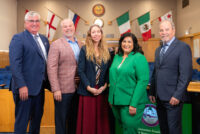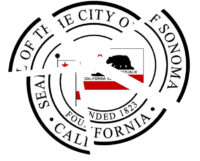How healthy are cell phone towers? How sick is the state budget? Where to find the answers and what can be done were the driving questions at the meeting of the Sonoma Valley Unified School District Board of Trustees on Tuesday night.
The topic that sparked the most debate at the meeting wasn’t even on the agenda. Almost two years ago, the trustees approved a contract allowing the construction of a cell phone tower near the tennis courts at Sonoma Valley High School. However, construction only recently began, catching the eye of several parents who voiced concerns at the meeting.
“None of the parents received notice the tower is going in. We receive notices warning us if there’s lice or strep throat. But we didn’t get a warning about this,” said parent Gerald Sanders, adding that he was not convinced by safety statistics. “We all know you can find statistics to support whatever your view is.”
He pointed out that children who start school in kindergarten at Prestwood would be in close proximity to the tower for 13 years.
“Studies show that children are more susceptible to radiation,” he said. “We’re here to tell the board to consider this very carefully. The amount of money this board is going to get annually will fall short of treating one person for cancer.”
Assistant superintendent Justin Frese, who brokered the deal on behalf of the board, was surprised by the sudden outpouring of community concern.
He said the city held a public hearing on the cell phone tower on Nov. 8, 2007 at the Sonoma Planning Commission, and then a second hearing April 10, 2008, when the commission gave final approval of the project.
Lauren Ayers, nicknamed “the Vitamin D Lady” by student trustee, Ethan Cohen, preceded her monthly lecture on the need for vitamin D (“Only two out of 10 people have enough vitamin D”) with a warning for the board about the possible hazards of radiation should the tower be installed.
Lee McDougle, a friend of Sanders, also rose to the podium to express concern. “EMF [electromagnetic field] is a real thing. It’s a constant hum. It’s low, but it’s constant. It’ll affect kids in the short and long term.”
“We’ve been laughing about the tower since it has these things that make it look like tree branches,” said student trustee Cohen. “After hearing about all the evils, maybe it’s not funny anymore.”
Trustee Nicole Abate Ducarroz noted that the board had looked at this 18 months ago, but wondered if there was some new information the board might consider. “I’m concerned about this. I’m glad people came tonight and spoke,” she said.
“At this point, we’re under contract,” said board president Dan Gustafson. “We did contract with consultants to provide us the information we needed at the time.” Trustee Helen Marsh said, “People are suing every man, woman and child in America over this kind of thing. The question is whether the acceptable level is safe.” Frese suggested it might be helpful to have a consultant come and talk to the board. New trustee Gary De Smet said, with emphasis, “We need to ask for the science. It sounds like we already did that.” Gustafson asked for calm and turned to trustee Camerino Hawing, who said, quietly, “This board doesn’t jeopardize the health of the kids. We asked the consultants. It was on the news. Some parents are concerned. But we can’t stop a process we’ve already agreed to unless there’s proof that it’s dangerous.” Gustafson asked if it would be possible to ask the experts if there’s any new information. “That would be my first stop,” said Frese, “going back to those experts.”
In our increasingly wired world, cell phone towers have raised concerns in various areas. In early 2008, the Sebastopol City Council suspended plans for a citywide Wi-Fi network over community concerns about radiation.
State budget still uncertain
The monthly business and financial report to the board occasioned another round of expressions of concern over what will happen if the state simply runs out of money.
After some debate, Marsh summed up the situation: “It sounds like if you do get some more flexibility on how we spend our categorical funds, that will allow us to weather the storm. But it doesn’t mean we won’t have to cut that budget. California is teetering on the edge of insolvency. We are dependent on California. We are looking at our source of income being seriously curtailed.”
Hawing called for giving Frese more guidance so that they would have a mitigation plan ready if the storm comes. He confirmed Frese’s previous assessment that the district is fine through June and July, but after that point faces uncertainty.




